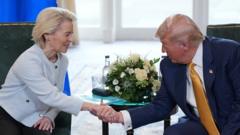The deal, brokered following intensive negotiations between President Donald Trump and European Commission President Ursula Von der Leyen in Scotland, establishes a US tariff of 15% on all EU goods, effectively halving the original 30% tax Trump had threatened to impose. In exchange, the EU will provide zero tariffs on select US products, fostering mutual economic support.
President Trump hailed the agreement as a "good deal for everybody," emphasizing its potential to deepen ties between the two allies who represent nearly a third of global trade. Von der Leyen echoed this sentiment, highlighting the agreement's role in bringing stability after "tough negotiations."
With Trump's broader trade strategy aimed at reshaping the global economic landscape and addressing the American trade deficit, the deal marks a significant step forward. The US president has been pursuing tariff agreements not just with the EU but also with countries like the UK, Japan, and Vietnam, although the goal of "90 deals in 90 days" remains unachieved.
During a private meeting at Trump’s Turnberry golf course in Scotland, the leaders agreed on the importance of investment, with the EU committing to an investment of $600 billion in the US. This investment will be directed towards American military equipment and energy, notably reducing European dependence on Russian power sources as a strategic priority.
Despite the positives, Trump confirmed that a 50% tariff on steel and aluminum would remain. The 15% tariff imposed relates to significant US revenue expectations, contributing an estimated $90 billion based on last year’s figures.
As trade flows between the US and EU totaled around $975.9 billion last year, the balance remains a contentious issue, with the US importing more than it exports. The EU, for its part, was prepared to retaliate against US imports, indicating the delicate equilibrium that now characterizes their economic relationship.
The day of the announcement coincided with Trump’s visit to his golf course in Scotland, with British Prime Minister Keir Starmer anticipating a meeting with Trump soon after to discuss further trade relations.
President Trump hailed the agreement as a "good deal for everybody," emphasizing its potential to deepen ties between the two allies who represent nearly a third of global trade. Von der Leyen echoed this sentiment, highlighting the agreement's role in bringing stability after "tough negotiations."
With Trump's broader trade strategy aimed at reshaping the global economic landscape and addressing the American trade deficit, the deal marks a significant step forward. The US president has been pursuing tariff agreements not just with the EU but also with countries like the UK, Japan, and Vietnam, although the goal of "90 deals in 90 days" remains unachieved.
During a private meeting at Trump’s Turnberry golf course in Scotland, the leaders agreed on the importance of investment, with the EU committing to an investment of $600 billion in the US. This investment will be directed towards American military equipment and energy, notably reducing European dependence on Russian power sources as a strategic priority.
Despite the positives, Trump confirmed that a 50% tariff on steel and aluminum would remain. The 15% tariff imposed relates to significant US revenue expectations, contributing an estimated $90 billion based on last year’s figures.
As trade flows between the US and EU totaled around $975.9 billion last year, the balance remains a contentious issue, with the US importing more than it exports. The EU, for its part, was prepared to retaliate against US imports, indicating the delicate equilibrium that now characterizes their economic relationship.
The day of the announcement coincided with Trump’s visit to his golf course in Scotland, with British Prime Minister Keir Starmer anticipating a meeting with Trump soon after to discuss further trade relations.





















